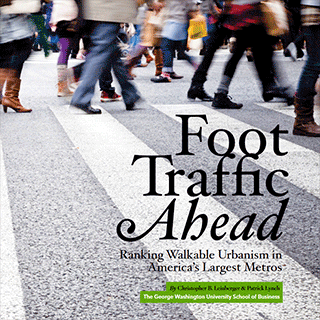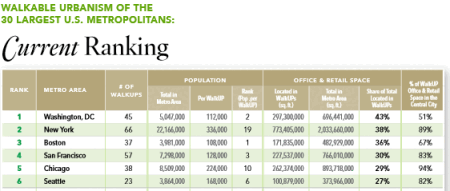New research shows that not only are walkable urban places (WalkUPs) in metropolitan areas ranging from New York City to Knoxville, Tennessee, on the rise nationally, but also the growing demand to locate in those areas is translating into significantly higher real estate rents.
According to Foot Traffic Ahead 2016, WalkUPs in all 30 of the largest U.S. metro areas studied are attracting the majority of new real estate development, with the office, retail, and apartment properties located in those areas commanding rents that are, on average, 74 percent higher compared with their peers in drivable suburban locations. The report was released in June by LOCUS: Responsible Real Estate Developers and Investors, a program of Smart Growth America, in conjunction with the Center for Real Estate and Urban Analysis at the George Washington University School of Business (GWSB). The Foot Traffic report is intended to put some quantifiable data behind the broader trend of urbanization and the value of walkable communities from both a real estate and a socioeconomic perspective.
Related: A Full List of the Walkable Neighborhoods included in Foot Traffic Ahead
One of the findings of the report is that walkable urbanism is on the rise and poised for even more growth ahead. Researchers found a total of 619 WalkUPs across the 30 metro areas, which is up compared to the 558 studied in the 2014 report. “We’re looking at the 30 largest metros in the U.S., and we’re seeing that they’re all moving in a similar direction towards increased walkable urbanism,” says Chris Leinberger, a Charles Bendit distinguished scholar and research professor of urban real estate and chair of the Center for Real Estate and Urban Analysis at the GWSB, and coauthor of the report.
WalkUPs are areas that have high density and a mix of uses such as office, retail, restaurants, and residential that are all contained within a “walkable” footprint of about 400 acres (162 ha). Those walkable places need to have zoning that allows mixed-use development to take place, as well as a variety of transit options. Another essential ingredient is an entity, such as a developer or city, that acts as a place manager to maximize value, Leinberger adds.
The report supports a strong economic case for continued expansion of walkable urban places. Rents at walkable urban office properties are 90 percent higher compared with properties located in drivable suburban locations; 71 percent higher for retail; and 66 percent higher for multifamily rental. And research indicates that rents have not yet peaked across most of these metro areas—25 of them. “That says there is not enough space for the demand as rents keep on going up over drivable suburban year after year. So, we think we have pent-up demand here for another 15 to 20 years,” says Leinberger.
It is no surprise that major metro areas such as New York City, D.C., and Boston top the rankings for walkable urban places. In addition to having a high number of WalkUPs—67 in the case of New York City—those top cities have a high percentage of retail, office, and rental multifamily space concentrated within those areas at between 22 and 38 percent.
However, the report outlined some key cities that are poised for future growth of walkability, including Phoenix, Los Angeles, and Detroit. The factors driving that growth are different for each metro area. Detroit, for example, is pushing for change that includes rail transit to turn around its struggling economy, whereas L.A. is working to combat its gridlock with the largest rail construction project now underway in North America.
Another factor that points to the growth potential for walkable urbanism is that one-third of the cities studied have 10 percent or less of their retail space located within WalkUPs. Many of the second-tier cities have the opportunity to move up, because they have lower land costs and they also are making major investments in the infrastructure that is required to support WalkUPs, says Christopher Coes, director of LOCUS, Smart Growth America’s national coalition of real estate developers and investors who advocate for sustainable, walkable development in America’s metropolitan areas.
Although one could argue that downtowns and central business districts (CBDs) have long charged premium rents, the research includes WalkUPs in both downtown and suburban areas of the metro areas studied. In the Washington, D.C., metropolitan area, for instance, nearly half of the walkable urbanism (47 percent) is located in suburban areas with WalkUPs in downtown Bethesda, Maryland; Tysons Corner in Fairfax County, Virginia; and Silver Spring, Maryland, among others. In fact, Arlington County, Virginia, alone is now home to seven different WalkUPs, Leinberger notes.
Both companies and individuals are choosing to locate in walkable urban places. In fact, all 30 metro areas reported an increase in market share for office and multifamily properties between 2010 and 2015, while suburban locations lost market share. In addition to the positive economic impact, the report opens the discussion to talk about the next phase, which is the impact of walkable urbanism on people, says Coes.
One of the new aspects of the 2016 report is that it looks at the social equity component of walkable urban places. Social equity is a major issue these days, with income inequality and fears about gentrification and displacement abounding. “The unusual thing we found is that the most walkable urban places are also the most socially equitable, in spite of their high housing prices,” says Leinberger. The research report shows that metro areas with the highest levels of walkable urbanism also are the most educated and wealthy, as measured by gross domestic product (GDP) per capita, and the most socially equitable. The reason for that is that households have lower transportation costs and accessibility to two to three times more jobs in walkable urban places, he adds.
“The report demonstrates that we have to think about housing and affordable commercial space a lot differently, because our initial assumption about what is truly affordable is counterintuitive,” Coes says. “If you only look at housing, you get one answer. But, if you bring housing and transportation together, you get another answer, and that requires a new level of thinking and a new approach to policy.”






![Western Plaza Improvements [1].jpg](https://cdn-ul.uli.org/dims4/default/15205ec/2147483647/strip/true/crop/1919x1078+0+0/resize/500x281!/quality/90/?url=https%3A%2F%2Fk2-prod-uli.s3.us-east-1.amazonaws.com%2Fbrightspot%2Fb4%2Ffa%2F5da7da1e442091ea01b5d8724354%2Fwestern-plaza-improvements-1.jpg)


